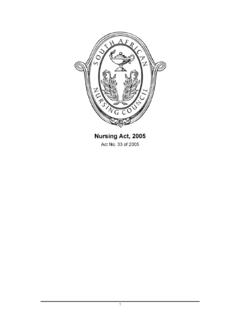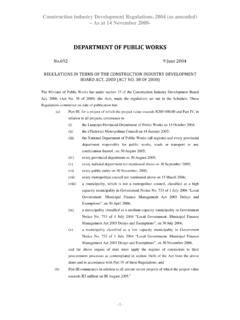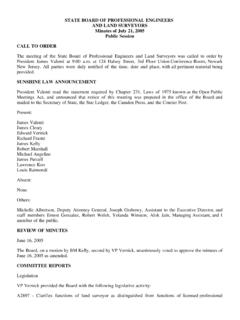Transcription of The Children Act 1989 Guidance and Regulations …
1 The Children Act 1989. Guidance and Regulations volume 4: fostering services fostering services 1 02/03/2011 17:00:49. Table of Contents Chapter 1 - Introduction ..5. The purpose of this How to use this Key principles and values ..7. Definitions ..7. Chapter 2: Responsibilities of local authorities and foster carers ..11. Corporate parenting ..11. The fostering task ..11. Parent and child Chapter 3 Ensuring the best for Children and young people ..14. Making and ending placements ..14. Foster carers' delegated authority ..15. Contact with family and friends ..18. Welfare ..19. Children 's wishes and Representations, complaints, rights and Identity and diversity, respect and individuality.
2 21. Achieving healthy outcomes for looked after Children ..22. Positive behaviour and taking Safeguarding looked after Children ..24. Allegations ..25. A safeguarding culture and ethos ..27. Children missing from the foster home ..28. Bullying ..29. Behaviour management, discipline, control and Educational Leisure activity ..32. Promoting independence and the transition to adulthood ..33. Chapter 4 - Management and staffing of the fostering Statement of purpose and Children 's The manager of the service ..35. Employment of staff ..36. Chapter 5 Approving and supporting foster Constituting fostering Conduct of fostering panels ..42. Recruitment, assessment and approval of foster carers.
3 43. The decision maker ..45. Independent Review Approval of people living overseas ..47. The usual fostering limit ..47. Temporary approval of a connected person as a foster Reviews and terminations of approval of foster carers ..50. Supporting foster Closure of fostering agencies ..52. Record 2. Annex A: Relationship between legislation, Guidance , standards and other material ..54. Key National minimum standards ..55. Statutory Guidance ..55. Non Statutory Government Advice ..56. Practice Guidance ..56. Annex B: Parent and child Introduction ..57. A voluntary arrangement by the local authority where the child is not looked A voluntary placement by the local authority where the child is looked after.
4 58. A voluntary placement by the local authority where both the child and parent are looked after ..59. An arrangement directed by the courts where the child is looked Placement with Parents ..59. The usual fostering limit ..59. 3. Preface 1. This Guidance sets out the functions and responsibilities of local authorities and their partner agencies in relation to fostering services under Parts 3, 7. and 8 of the Children Act 1989. It also sets out the responsibilities arising from the Children Act 2004 and the Children and Young Persons Act 2008 in relation to fostering services . It is issued as Guidance under Section 7 of the Local Authority Social services Act 1970, which requires local authorities in exercising their social services functions, to act under the general Guidance of the Secretary of State.
5 Local authorities should comply with this when exercising these functions, unless local circumstances indicate exceptional reasons that justify a variation. 2. This Guidance is addressed to: Children 's services social workers;. frontline managers with particular responsibilities in relation to looked after Children ;. lead members for Children 's services in local authorities;. directors of Children 's services ;. managers of services for looked after Children ;. commissioners of services for looked after Children ;. virtual head teachers, independent reviewing officers and other professionals with responsibilities in relation to looked after Children . 3. It will also be relevant to: Children 's services partner agencies as set out under section 10 of the Children Act 2004.
6 Registered fostering agencies;. Children who are fostered and their families;. foster carers and their families. 4. In addition, it gives Guidance to independent fostering agencies about their responsibilities under the Care Standards Act 2000. Local authorities, in acting as commissioners of placements with independent fostering agencies, should be aware of and take note of the requirements on those providers under this legislation and reflect it in their commissioning standards and contract specifications. This Guidance helps them to do so. 5. This Guidance covers fostering services for Children who are looked after by local authorities. It does not cover private fostering arrangements, which are the subject of separate statutory Guidance .
7 1. 1. Replacement Children Act 1989 Guidance on Private fostering , DCSF 2005. 4. Chapter 1 - Introduction The purpose of this Guidance Any good parent wants to make sure their Children enjoy good emotional and physical health, an excellent education and a wide range of opportunities to enjoy their childhood so that they have every chance to grow up into successful, well rounded and mature adults. Local authorities are responsible for securing this for the Children they look after. For the majority of looked after Children the quality of the care provided by foster carers is an essential part of that parenting. This Guidance contains the requirements set out by Government to support local authorities, working with fostering service providers, in giving the best possible care and support to the Children they look after.
8 These requirements support the local authority in its primary duty, provided for in section 22(3) of the Children Act 1989, to safeguard and promote the welfare of looked after Children . This includes a particular duty to promote the child's educational achievement and in acting as good corporate parents to enable each looked after child to achieve their full potential. In order to be satisfied that they are adequately exercising their duties under section 22, local authorities should ensure that any services they commission from fostering agencies comply with the functions, duties and powers of that Act. The Guidance takes into account the requirements set out in the Care Standards Act 2000 and relevant Regulations , especially the fostering services (England) Regulations 2011.
9 It directly relates to National Minimum Standards (NMS) for fostering services (2011) set by the Government and used by Ofsted in their inspections of fostering services . The text refers to the relevant part of the fostering services (England) Regulations 2011, and the relevant NMS. This Guidance has been informed by the views of looked after Children and young people, who were asked by the Children 's Rights Director to comment on how they feel they should be cared for and the standards there should be for their care. The report that was produced about young people's views was used in preparing this Guidance . 2. How to use this Guidance This Guidance is designed to provide a framework for practice in providing a fostering service, which emphasises the importance of safeguarding and promoting the welfare of individual Children .
10 It is not intended to be a detailed guide to good practice but to set out the core things that must be done by those commissioning and providing fostering services , in order to deliver a responsive and quality service for some of our most vulnerable Children . Those working with local authorities as providers or partners should follow it. The relationship between legislation, statutory Guidance and practice Guidance is set out in Annex A. 2. Children 's Messages on Care 2010; A report by the Children 's Rights Director for England, Ofsted 2010. 5. This Guidance is part of a suite of revised volumes of Regulations and Guidance issued in relation to the Children Act 1989, and supersedes The Children Act 1989 Guidance and Regulations volume 3: Family Placements issued in 1991.





